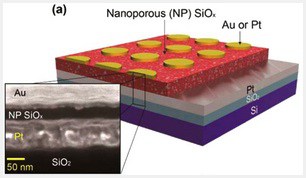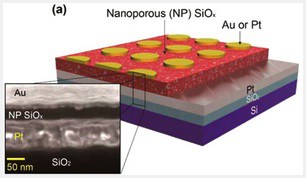
Investment in the ultimate promise of advanced or molecular nanotechnology, that is, molecular manufacturing or atomically precise manufacturing, may well rest upon the success of current nanoscale science and incremental nanotechnology. Computation represents a major area of investment for current nanotechnology. One researcher who has contributed greatly to both atomically precise devices leading toward molecular manufacturing, on the one hand, and current commercializable nanotechnology, on the other hand, is James Tour of Rice University, winner of the 2008 Foresight Institute Feynman Prize in the Experimental category. A hat tip to KurzweilAI for reprinting this Rice University news release “Rice’s silicon oxide memories catch manufacturers’ eye“:
Rice University’s breakthrough silicon oxide technology for high-density, next-generation computer memory is one step closer to mass production, thanks to a refinement that will allow manufacturers to fabricate devices at room temperature with conventional production methods.
First discovered five years ago, Rice’s silicon oxide memories are a type of two-terminal, “resistive random-access memory” (RRAM) technology. In a new paper available online in the American Chemical Society journal Nano Letters [abstract], a Rice team led by chemist James Tour compared its RRAM technology to more than a dozen competing versions.
“This memory is superior to all other two-terminal unipolar resistive memories by almost every metric,” Tour said. “And because our devices use silicon oxide — the most studied material on Earth — the underlying physics are both well-understood and easy to implement in existing fabrication facilities.” Tour is Rice’s T.T. and W.F. Chao Chair in Chemistry and professor of computer science and of materials science and nanoengineering.
Tour and colleagues began work on their breakthrough RRAM technology more than five years ago. The basic concept behind resistive memory devices is the insertion of a dielectric material — one that won’t normally conduct electricity — between two wires. When a sufficiently high voltage is applied across the wires, a narrow conduction path can be formed through the dielectric material.
The presence or absence of these conduction pathways can be used to represent the binary 1s and 0s of digital data. Research with a number of dielectric materials over the past decade has shown that such conduction pathways can be formed, broken and reformed thousands of times, which means RRAM can be used as the basis of rewritable random-access memory.
RRAM is under development worldwide and expected to supplant flash memory technology in the marketplace within a few years because it is faster than flash and can pack far more information into less space. For example, manufacturers have announced plans for RRAM prototype chips that will be capable of storing about one terabyte of data on a device the size of a postage stamp — more than 50 times the data density of current flash memory technology.
The key ingredient of Rice’s RRAM is its dielectric component, silicon oxide. Silicon is the most abundant element on Earth and the basic ingredient in conventional microchips. Microelectronics fabrication technologies based on silicon are widespread and easily understood, but until the 2010 discovery of conductive filament pathways in silicon oxide in Tour’s lab, the material wasn’t considered an option for RRAM.
Since then, Tour’s team has raced to further develop its RRAM and even used it for exotic new devices like transparent flexible memory chips. At the same time, the researchers also conducted countless tests to compare the performance of silicon oxide memories with competing dielectric RRAM technologies.
Our technology is the only one that satisfies every market requirement, both from a production and a performance standpoint, for nonvolatile memory,” Tour said. “It can be manufactured at room temperature, has an extremely low forming voltage, high on-off ratio, low power consumption, nine-bit capacity per cell, exceptional switching speeds and excellent cycling endurance.”
In the latest study, a team headed by lead author and Rice postdoctoral researcher Gunuk Wang showed that using a porous version of silicon oxide could dramatically improve Rice’s RRAM in several ways. First, the porous material reduced the forming voltage — the power needed to form conduction pathways — to less than two volts, a 13-fold improvement over the team’s previous best and a number that stacks up against competing RRAM technologies. In addition, the porous silicon oxide also allowed Tour’s team to eliminate the need for a “device edge structure.”
“That means we can take a sheet of porous silicon oxide and just drop down electrodes without having to fabricate edges,” Tour said. “When we made our initial announcement about silicon oxide in 2010, one of the first questions I got from industry was whether we could do this without fabricating edges. At the time we could not, but the change to porous silicon oxide finally allows us to do that.”
Wang said, “We also demonstrated that the porous silicon oxide material increased the endurance cycles more than 100 times as compared with previous nonporous silicon oxide memories. Finally, the porous silicon oxide material has a capacity of up to nine bits per cell that is highest number among oxide-based memories, and the multiple capacity is unaffected by high temperatures.”
Tour said the latest developments with porous silicon oxide — reduced forming voltage, elimination of need for edge fabrication, excellent endurance cycling and multi-bit capacity — are extremely appealing to memory companies.
“This is a major accomplishment, and we’ve already been approached by companies interested in licensing this new technology,” he said.
Prof. Tour’s contributions to nanotechnology for computation go back at least to a paper he presented at the 1997 Fifth Foresight Conference on Molecular Nanotechnology titled “Molecular Scale Electronics. Syntheses and Testing“.
—James Lewis, PhD

